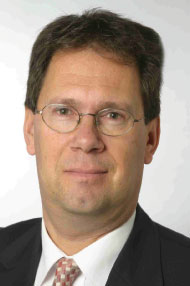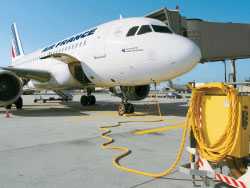
Since 2001, Fraport has been levying differentiated noise-related charges for airlines as part of the airport’s fixed landing and takeoff charges. There is also an additional night surplus charge for take-off and landing during two night time intervals.

Stefan Mauel, Fraport’s head of infrastructure: “Together with Lufthansa, the German Air Traffic Control company Deutsche Flugsicherung and the government, Fraport has agreed to a declaration for developing active noise abatement measures in the coming years. The aim of the declaration is to reduce significantly the aircraft noise expected in 2020.”
As Germany’s biggest hub located in a densely populated conurbation, Fraport recognises that while currently operating to full capacity, the airport must balance its commercial case for growth – which initially rests on completion of a fourth landing runway for the Winter 2011 timetable – with its long-term commitment to reducing noise and noise-related emissions on the ground. With completion of a fourth runway, Fraport will be able to accommodate around 700,000 aircraft movements per year (an additional 200,000 annual movements), with a long-term view to extend capacity to 88 million passengers by 2020. “The opening of the new Runway Northwest will achieve a major step in expanding capacity at Frankfurt, which will inevitably lead to more aircraft movements and an increase in the local noise load for some of the surrounding communities. Fraport has therefore committed itself to developing active noise abatement measures which could reduce the originating noise impact,” explained Mauel.
Latest figures released by Fraport show that in the first quarter of 2009 passenger demand dropped 10.9%, while the decline in the second quarter lessened to 5.6% and in the third quarter to 2.8%. Fraport’s executive board chairman Dr. Stefan Schulte expects to see further signs of a recovery by early next year. “Even in these times of crisis, airline demand for slots at Frankfurt airport clearly exceeds FRA’s capacities,” he explained.

Fraport operates a noise-monitoring system at Frankfurt airport with 26 noise-monitoring terminals and two mobile units.
As expansion continues, so will work across its well-established noise insulation programme. According to Mauel, €50 million has been spent on insulating homes in the local community since 2002 and this will increase by around €90 million to coincide with the new runway.
In May 2000, Fraport put in place a 10-point action programme to facilitate noise protection within its long-term expansion programme. Reducing noise from aircraft arrival procedures is one key element.

€50 million has been spent on insulating homes in the local community since 2002 and this will increase by around €90 million to coincide with the new Northwest Runway.
The ‘Frankfurt Approach Procedure’ has been adopted since the 1970s through Fraport’s partnership with the airport’s hub airline Lufthansa and the German Air Traffic Control company Deutsche Flugsicherung. It aims to maintain rather than restrict capacity levels, but places emphasis on the technique of approach by each aircraft in lowering noise emissions. “We have identified new segmented approaches, dedicated runway operations (DROPS) and optimised take-off procedures. In addition, DFS German Air Navigation Services is doing a lot of work in developing and approving the Continuous Descent Approaches at Frankfurt and other airports in Germany,” explained Mauel.
DFS also defines the approach and departure routes for aircraft, which ensures their safe operations, while avoiding the most heavily populated areas.
Other measures in the 10-point programme include the possible relocation of overnight flights to Frankfurt-Hahn airport – an option that is still being considered and further improvement of noise monitoring. Currently, there are 26 noise monitoring terminals around the airfield and two mobile units, with a dedicated department within the Traffic and Terminal Management Division regularly publishing noise level results.
Fraport is also evaluating low-noise approach and departure procedures at night. “This can be achieved by optimising the approach path using new technologies and procedures provided by satellite and area navigation technologies (RNAV/RNP). The other possibility is to increase the glide path angle to achieve a steeper approach, which will result in a higher overflying height in the local area,” said Mauel.
Noise and emissions charges

Mauel: “One measure we are increasing to reduce noise is the use of ground power units (GPUs) at parking stands through collaboration with airlines.”
Since 2001, Fraport has been levying differentiated noise-related charges for airlines as part of the airport’s fixed landing and takeoff charges. These charges could be increased further under the 10-point programme to further discourage night activity to reduce aircraft-related noise. Rather than traditionally basing charges on aircraft takeoff weight, charges are currently set according to the noise category each aircraft falls into (according to their ICAO classification) and are based on ‘average’ take-off noise levels, with the overriding aim of encouraging airlines to use quieter aircraft that also produce fewer emissions.
“Fraport considers noise and air emissions to be very important issues and both factors are considered in our charging system,” said Mauel. In 2008 Frankfurt was among a number of German airports to introduce an emission-relation charge. “However, through discussions with neighbouring communities, noise remains the most important issue to them,” he added.
Fraport has defined eight noise categories, with charges increasing progressively across the categories. “For example, an A320 (Category 1) has to pay a noise-related charge of €24, while a B747-400 (Category 4) must pay €530 – 22 times as much as for the A320 daily turnaround,” said Mauel.
There is also an additional night surplus charge for take-off and landing during two night time intervals (between 22:00 and 22:50 and 05:00 and 05:59) and a further surplus charge for inbound or outbound flights between 23:00 and 04:59 (local time). The airport’s noise quota system, which has been in place since the 2002 summer timetable, has also been an active measure in reducing noise from night time flying. Quotas are set on a seasonal basis and regularly reviewed.
Fraport is also working with third parties, including airlines, to address noise directly on the ground through various key initiatives, explained Mauel. “One measure we are increasing is the use of ground power units (GPUs) at parking stands instead of aircraft using their own engine power. We are also currently testing the use of electric cars with the aim of replacing petrol-powered vehicles, which will not only reduce our CO2 footprint but electric engines are quieter too.”







